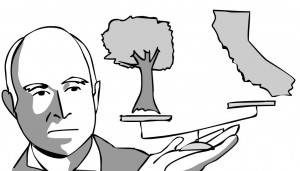Brown can’t color nation green
It seemed clear throughout the last few weeks, as Meg Whitman struggled to clean up the mess her maid left and attempted to convince voters of her financial savvy while wildly blowing through $142 million of her own money, that California was leaning Brown.
Now that he’s been elected, the focus is shifting away from the amusement of the gubernatorial race and instead settling on the number of promises that Governor-elect Jerry Brown made during his campaign.
Among those promises was the decisive investment of time and money in a clean-energy jobs plan.
“Over the next decade, the market for renewable energy will triple to more than $2 trillion,” Brown said. “California must be at the forefront of this 21st century economic engine. We led the way once, and I know how to put California first again.”
It’s easy enough to hope that such an agenda will quickly rise to the forefront of state policy and be subsequently snapped up by an enlightened federal government. Exciting a prospect as that might be, many Californians aren’t likely to be surprised should the advancement of that plan quietly take a backseat to the long-reigning paramounts of education, budget and healthcare — as voters, we’ve been burned before.
But there are hopeful indications that California’s commitment to clean-energy jobs might prove to be more than just another unfilled campaign promise or short-lived publicity strategy.
Brown’s eight-point plan, building from the cornerstones of renewable energy and efficiency, is ambitious but not entirely unrealistic; he has already garnered a battalion of supporters in Silicon Valley — Google, Apple and Bill Gates all did their part in the policy tug of war against companies such as Valero and Tesoro oil that was Proposition 23.
It’s more than an optimistic naivety that has California’s best and brightest standing by Brown as he works to advance the precedents in his environmental agenda. They might not have endorsed Brown personally, as have organizations such as the Sierra Club, but they do recognize that from a business perspective they stand a lot to gain from a government that promotes clean energy.
Dovetailing interests between a determined leader and a score of high-profile constituents can carry a platform a long way. And California, as the nation’s self-proclaimed trailblazer, is just progressive enough to be the state that doesn’t let its environmental agenda go the way of the dinosaur.
Still, in-state support is a far cry from implementation of a clean-energy jobs plan on the federal level that will be needed to ensure it’s not forgotten, especially once Brown’s term is up. It also isn’t likely to help that half of the new Republican members of Congress are “climate change skeptics,” according to an analysis by the Center for American Progress.
Despite the size of California’s economy, industry and voting population, the state is not always a powerful enough force to drag the rest of the nation behind it; there are an incalculable number of promising initiatives born in California that were not taken up in other state policies. For the clean-energy jobs plan to be different, Brown will first need to concentrate on expanding his base of support in California — for now, at least, we should keep our focus within state lines.
Holding off on expanding the concept of clean-energy jobs outside California is not an admission of defeat; for the time being, it’s a sound tactic of demonstrating to the rest of the country just how successfully we can integrate environmentally friendly policies into our economy and thus inspire them to follow suit in their own time.
“Investments in clean energy produce two to three times as many jobs per dollar as gas, oil or coal. And dollars invested in clean energy tend to stay in California, instead of going to other states or other countries,” Brown said at the Silicon Valley Leadership Group.
Should the clean-energy jobs plan prove a boon to California’s economy, we’ll be able to see the remaining states recognize its value and implement similar plans of their own accord.
Kastalia Medrano is a sophomore majoring in print and digital journalism and editorial director of the Daily Trojan. Her column, “Green Piece,” runs Tuesdays.


Brown’s statement, “Investments in clean energy produce two to three times as many jobs per dollar as gas, oil or coal. And dollars invested in clean energy tend to stay in California, instead of going to other states or other countries,” is wishful thinking. Many alternative energy businesses (even those started under Jimmy Carter) are subsidy farms. You can tell they are, because, every time the subsidies are threatened, the industry laments the end of alternative energy.